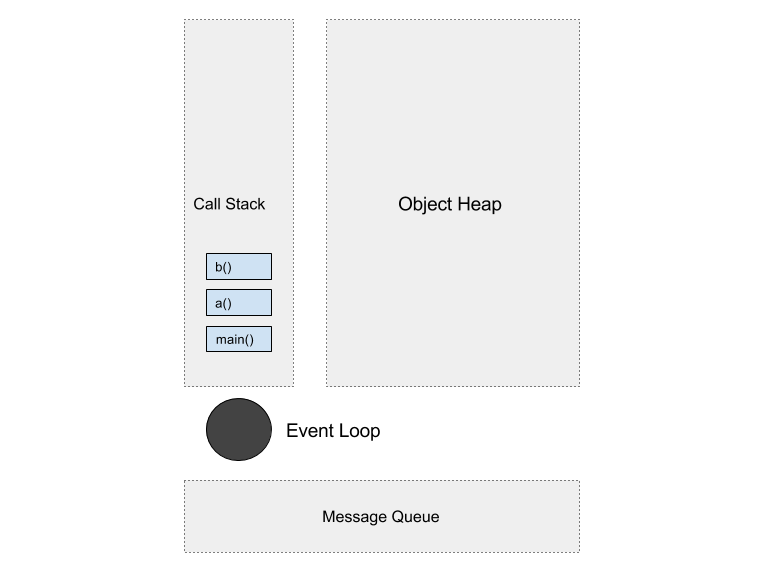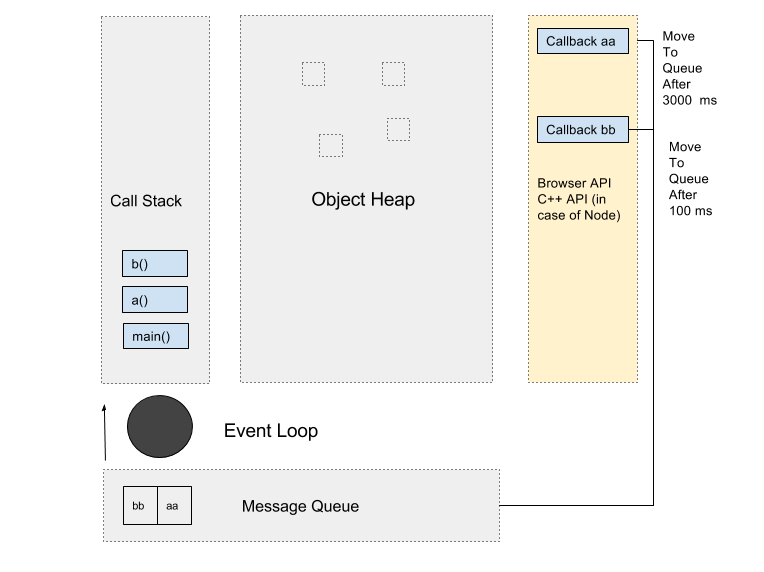JavaScript — Event Loop & Concurrency
In this article we will try to figure it out that how event loop and concurrency actually works in javascript.
Javascript,a single threaded, functional language.
One thread == One call stack == One thing at a time
Have you ever wondered that despite of being single threaded, functional language, how javascript handles our callback ? During execution where our callbacks goes and how they come back in our call stack after certain amount of time ? So let try to figure it out that how javascript execute our functions internally . How javascript engine performs our function execution.
We will start with a simple function execution. Let’s assume we have following code snippet.So when we execute it, Internally javascript engine creates three main component during run time.

function a(){
console.log(“a”);
b();
}
function b(){
console.log(“b”);
}
a();
Call Stack —It is the main thread by which execution of our program takes place. During run time, engine create frames, which contains arguments and variables of that function (not objects) and push them into call stack. main is our entry frame by which execution starts, after that it will create a frame for a and push it into call stack. Inside a we are calling b, soit willcreate a frame for b and push it into call stack. When execution of any function finishes it will pop corresponding frame from the call stack.
Object Heap — It is nothing but a memory space where objects resides.
Message Queue — During execution, javascript engine (V8) also maintains a message queue. Whenever our browser find out that timer for a particular callback is completed it pushes that function to the message queue. It is a pipe which browser uses for sending their event to the main execution call stack for execution. So message queue is nothing but collection of callbacks which are waiting for the execution.
Now for more clarity let’s extend our example and add some callbacks. so we have added function aa and bb in function (by using web api, setTimeout) aand b respectively with timeout 3000ms and 100ms.
setTimeout is a web API which is handled by the browser concurrently . You can call web API’s and they will keep working on them in separate thread.

function a(){ console.log(“a”); setTimeout(function aa(){
console.log(“aa”);
},3000);
b();
}
function b(){ setTimeout(function bb(){
console.log(“bb”);
},100);
console.log(“b”);
}
a();
Starting with main frame, engine will create frame for function a and push it to call stack and browser start timer for function aa. After that engine creates frame for function b and pushed it into call stack. Similar as aa, for function bb also, browser kicks a timer for it.
On the one hand our call stack execution is going on and it pops frames from call stack as b,a and then main, and on the other handat the same timecallback timer is ticking. Whichever callback timer complete its duration first (regardless which started first) it will move to the message queue. So, in this case even though timer for aa is started first but it is taking more time then bbso in message queue, bb moves before the aa.
Now significance of Event Loop comes in picture.
Event loop is continuously ticking during the whole process and watching the call stack and message queue. As soon as it finds out that all frames of call stack (a,b and main ) is popped and call stack is empty, it started creating frames for callback functions (bb,aa) and pushing them into call stack from message queue. Here you can see event loop waited for the completion of previous call stack before pushing message queue frames to them. It means whatever time we provides in our callback that is the minimum time which it will take to execute.
Conclusion
So crux is, even though Javascript is single threaded, our browser and node provides us the API’s which we can call for concurrency execution and event loop will help in pipelining those execution results from message queue to the call stack.
hyrglobalsource– We are experts in identifying legacy IT systems/software and replacing it with high fidelity advanced technologies.
